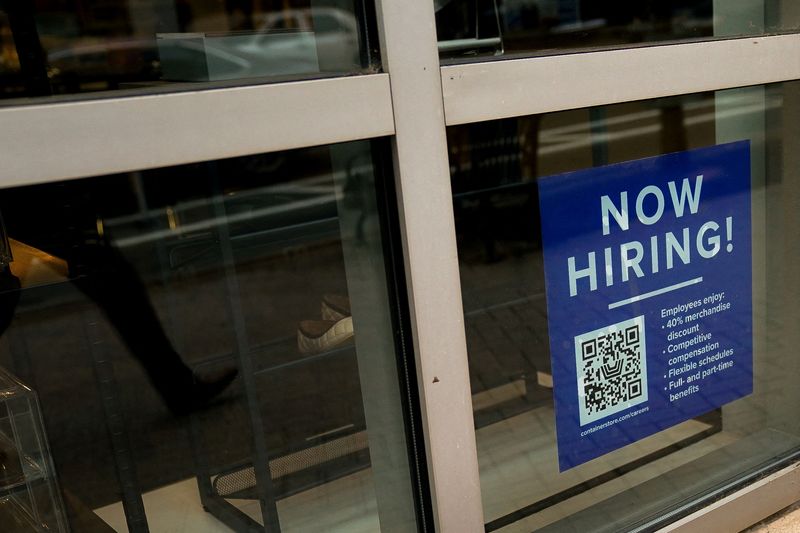By Lucia Mutikani
WASHINGTON (Reuters) - The U.S. economy added the fewest jobs in 2-1/2 years in June, but persistently strong wage growth pointed to still-tight labor market conditions that most certainly ensure the Federal Reserve will resume raising interest rates later this month.
The Labor Department's closely watched employment report on Friday also showed 110,000 fewer jobs were created in April and May, indicating that higher borrowing costs were starting to dampen businesses' appetite to continue boosting headcount. There was also a jump in the number of people working part-time for economic reasons last month, in part because their hours had been reduced due to slack work or business conditions.
Nevertheless, the pace of jobs growth remains strong by historical norms and added to data this week showing an acceleration in services sector activity in suggesting that the economy was nowhere near a long-forecasted recession.
"The payroll numbers gave a whiff of weakening, but the labor market remains strong," said Sean Snaith, the director of the University of Central Florida's Institute for Economic Forecasting. "By no means is the Fed's work done. We're in a protracted battle against inflation, and nothing in today's report suggests otherwise."
Nonfarm payrolls increased by 209,000 jobs last month, the smallest gain since December 2020, the survey of establishments showed. Economists polled by Reuters had forecast payrolls rising 225,000. It was the first time in 15 months that payrolls missed expectations.
Job growth averaged 278,000 per month in the first half of the year. The economy needs to create 70,000-100,000 jobs per month to keep up with growth in the working-age population.
Employment growth is in part being driven by companies hoarding workers, a legacy of the dire labor shortages experienced as the economy rebounded from the COVID-19 pandemic downturn in 2021 and early 2022.
While higher-paying industries such as technology and finance are purging workers, sectors like leisure and hospitality as well as local government education are still catching up after losing employees and experiencing accelerated retirements during the pandemic.
Government employment increased by 60,000, boosted by a 59,000 rise in state and local government payrolls. Government employment remains 161,000 below its pre-pandemic levels.
Private payrolls increased 149,000, also the smallest gain since December 2020. Healthcare payrolls rose 41,000, reflecting increases in hiring at hospitals, nursing and residential care facilities as well as home health care services.
Construction employment jumped by 23,000. The housing market is showing signs of revival after being battered by a surge in mortgage rates. The Fed has raised its policy rate by 500 basis points since March 2022 when it embarked on its fastest monetary policy tightening campaign in more than 40 years.
There were also increases in professional and business services employment, though temporary help, seen as a harbinger for future hiring fell 12,600. Manufacturing payrolls rebounded moderately as the sector struggles with softening demand. Retail jobs, however, fell 11,200.
Leisure and hospitality payrolls increased 21,000. The pace has, however, slowed from the first quarter. Demand could either be slowing or businesses are having trouble finding workers as alluded to in the Institute for Supply Management's June survey, which showed some services businesses reported being "unable to find qualified candidates for some open positions."
There were 1.6 job openings for every unemployed person in May, government data showed on Thursday. Leisure and hospitality employment remains 369,000 below its pre-pandemic levels.
Stocks on Wall Street were mixed. The dollar fell against a basket of currencies while U.S. Treasury prices rose.
STRONG WAGE GAINS
With workers still scarce in some industries, average hourly earnings rose 0.4% after climbing by the same margin in May. That kept the annual increase in wages at 4.4% in June, too high to be consistent with the Fed's 2% inflation target.
The average workweek rose to 34.4 hours from 34.3 hours in May. It is, however, below the average 34.6 hours in January.
"Companies are continuing to retain and add to their workforce, but are not increasing weekly hours," said Selcuk Eren, senior economist at the Conference Board in Washington. "That's consistent with CEOs in a slowing economy choosing to hold onto workers, potentially with reduced hours, rather than let them go for fear of future hiring difficulties."
Labor hoarding is helping the economy to stave off a recession, but at the expense of productivity, which slumped in the first quarter, and profits margins. Economists see companies wielding the axe if the pressure on profits intensifies.
The household survey from which the unemployment rate is derived showed employment rebounding 273,000, reversing the 310,000 decline in May. That more than offset an increase in the number of people entering the labor force.
As a result, the unemployment rate slipped to 3.6% in June from a seven-month high of 3.7% in May. The unemployment rate has remained in a 3.4%-3.7% range since March 2022.
But the number of people employed part time for economic reasons increased by 452,000 to 4.2 million, partially reflecting an increase in those whose hours were cut due to slack work or business conditions.

The labor force participation rate, or the proportion of working-age Americans who have a job or are looking for one, was unchanged at 62.6% for a fourth straight month. But the participation rate for the 25-54 age group rose to 83.5%, the highest level since May 2002, from 83.4% in May.
"Though demand for labor remains unmatched, the labor shortages that employers sighed over a year ago have definitely subsided some," said Andrew Flowers, lead labor economist at Appcast. "This strong labor market has pulled workers in from the sidelines."
